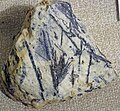v50 Steam/Premium information for editors
- v50 information can now be added to pages in the main namespace. v0.47 information can still be found in the DF2014 namespace. See here for more details on the new versioning policy.
- Use this page to report any issues related to the migration.
This notice may be cached—the current version can be found here.
File:Stibnite (Bohemia Mining District, Oregon, USA) (18929751411).jpg
Jump to navigation
Jump to search


Size of this preview: 648 × 600 pixels. Other resolutions: 259 × 240 pixels | 519 × 480 pixels | 830 × 768 pixels | 1,106 × 1,024 pixels | 3,027 × 2,802 pixels.
Original file (3,027 × 2,802 pixels, file size: 3.01 MB, MIME type: image/jpeg)
File history
Click on a date/time to view the file as it appeared at that time.
| Date/Time | Thumbnail | Dimensions | User | Comment | |
|---|---|---|---|---|---|
| current | 18:45, 27 July 2015 |  | 3,027 × 2,802 (3.01 MB) | Natuur12 | Transferred from Flickr via Flickr2Commons |
File usage
The following 5 pages use this file: